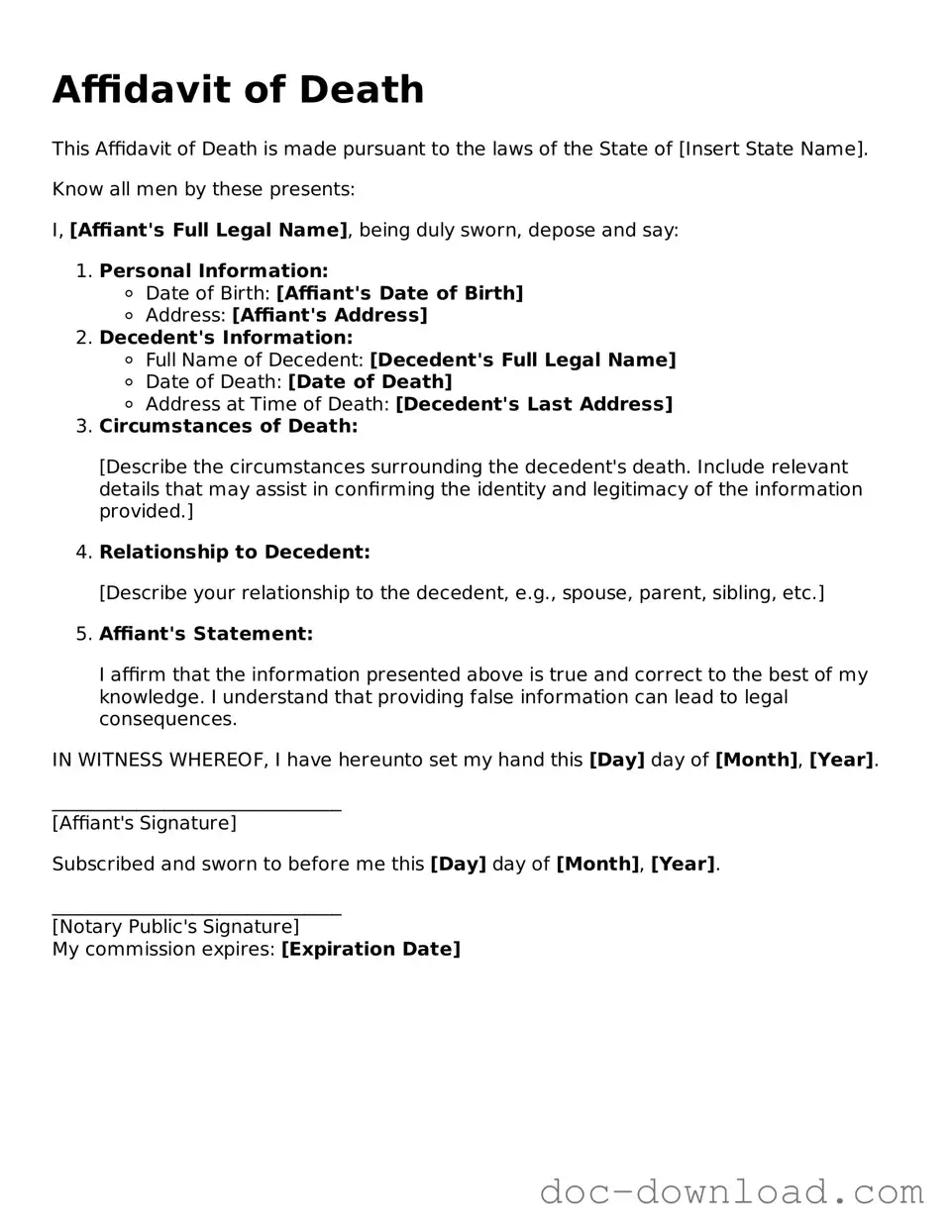The Affidavit of Death form shares similarities with the Death Certificate. A Death Certificate is an official document issued by a government authority that confirms a person's death. Both documents serve as proof of death, but the Death Certificate is typically required for legal purposes such as settling estates, while the Affidavit of Death may be used in specific situations, such as transferring property ownership or settling insurance claims.
Another document comparable to the Affidavit of Death is the Will. A Will outlines how a person's assets should be distributed after their death. While the Affidavit of Death confirms that the individual has passed away, the Will provides instructions on what should happen next. Both documents are crucial in the estate planning process and can help streamline the legal proceedings following a person's death.
The Probate Petition is another related document. This legal request is filed with the court to initiate the probate process after someone dies. Like the Affidavit of Death, the Probate Petition requires proof of death. However, the Probate Petition goes a step further by requesting the court's approval to manage the deceased's estate. Both documents are essential in ensuring that the deceased’s wishes are honored and that their assets are distributed appropriately.
The Letter of Administration is also similar to the Affidavit of Death. This document is issued by a court to authorize a person to manage and distribute the assets of someone who has died without a Will. The Affidavit of Death provides evidence of the individual’s death, while the Letter of Administration grants legal authority to act on behalf of the deceased's estate. Both documents play vital roles in the estate management process.
The Certificate of Trust can also be compared to the Affidavit of Death. A Certificate of Trust verifies the existence of a trust and outlines its terms. When a trust is involved, the Affidavit of Death may be needed to prove that the individual has passed away, which can trigger the distribution of assets held in the trust. Both documents are instrumental in managing the deceased's assets effectively.
The Living Will is another document that can be likened to the Affidavit of Death. A Living Will outlines a person's wishes regarding medical treatment in the event they become incapacitated. While the Affidavit of Death pertains to confirming death, both documents reflect an individual’s intentions regarding their health and estate. They are essential for ensuring that a person's wishes are respected even after they can no longer communicate them.
The Durable Power of Attorney (DPOA) also has similarities with the Affidavit of Death. A DPOA allows an individual to designate someone to make decisions on their behalf while they are still alive but incapacitated. If the individual passes away, the Affidavit of Death is needed to terminate the authority granted by the DPOA. Both documents play crucial roles in managing a person's affairs during and after their lifetime.
Understanding the importance of legal documents in estate planning is crucial for ensuring that a person's wishes are honored after their passing. For individuals considering their healthcare preferences, utilizing a Colorado PDF Forms can greatly facilitate the process of creating a Medical Power of Attorney, empowering them to designate someone to make vital medical decisions on their behalf when necessary.
The Medical Power of Attorney (MPOA) is another document that relates to the Affidavit of Death. An MPOA designates someone to make healthcare decisions for a person who is unable to do so. When the individual dies, the Affidavit of Death serves as confirmation of their passing, which is necessary to end the MPOA's authority. Both documents ensure that a person’s healthcare and estate wishes are honored.
The Notification of Death is also similar to the Affidavit of Death. This document is often used to inform relevant parties, such as financial institutions or insurance companies, about a person's death. While the Affidavit of Death serves as a formal declaration, the Notification of Death is typically a more informal communication. Both are essential in initiating the process of settling the deceased's affairs.
Lastly, the Social Security Administration (SSA) Death Report is comparable to the Affidavit of Death. This report is filed to notify the SSA of an individual's death, which is necessary for stopping benefits and preventing fraud. The Affidavit of Death serves a similar purpose by providing legal proof of death. Both documents help ensure that the deceased's records are updated and that any benefits are appropriately managed.
